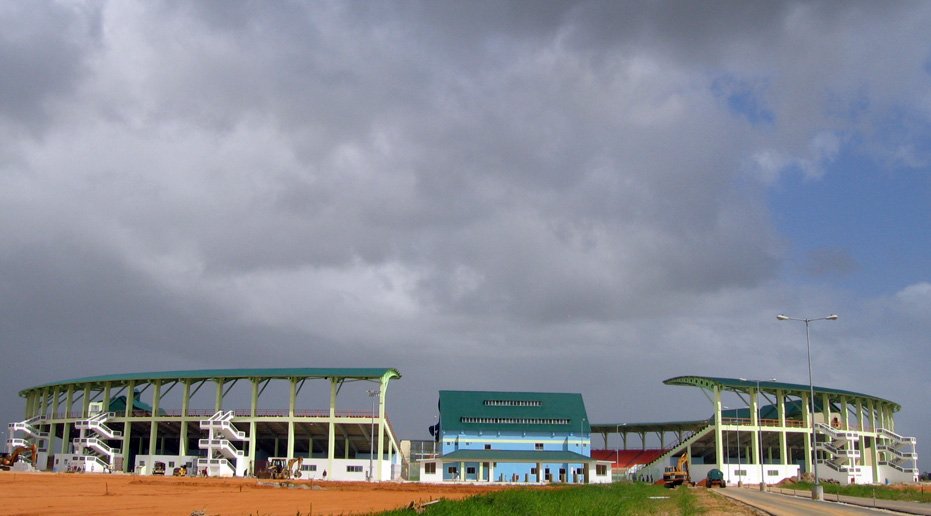Close

GEORGETOWN – The dream of a world-class football facility in Guyana is on its way to becoming reality as ground was broken for the country’s first dedicated national football stadium. In an upbeat ceremony at Durban Park in Georgetown, government officials joined the Guyana Football Federation (GFF) and international partners to turn the sod for what’s been dubbed the “Blue Water Shipping National Stadium.” This project, a partnership between the GFF, Danish company Blue Water Shipping, and the government, marks a historic milestone for local football. “It’s truly a monumental moment for football in Guyana,” said GFF President Wayne Forde at the October 18, 2024 event. After decades of using a cricket ground for big football matches, Guyanese players and fans can finally look forward to a purpose-built home for the beautiful game.
The planned stadium will occupy a 7.3-acre site at Durban Park, on land that the government has leased to the GFF for 50 years. The facility is designed to seat between 8,000 and 12,000 spectators, with expansion capacity, and meet all FIFA standards. Blue Water Shipping, which acquired naming rights in a five-year deal, is providing technical expertise and some financing, while FIFA and CONCACAF are also contributing funds and advisory support. The government’s role has been pivotal – beyond providing land, it has fast-tracked approvals and will assist with necessary utilities and infrastructure around the venue. “Our administration is fully behind this,” proclaimed Minister of Sport Charles Ramson Jr. at the ceremony. “We see it as an investment in our youth and in Guyana’s sporting future.” Indeed, the stadium aligns with the PPP/C government’s broader sports development thrust, which in recent years has included building or upgrading facilities for cricket, athletics, and now football across the country.
Concacaf President and FIFA Vice-President Victor Montagliani flew in for the groundbreaking, underscoring its significance. He praised Guyana’s progress, noting that improved infrastructure is “critical to inspire future generations of footballers.” For years, Guyana’s national teams have had no permanent training base; the senior men’s “Golden Jaguars” played home matches at the National Track and Field Centre (which doubles as a football pitch) or the Providence cricket stadium in a less-than-ideal setup. The new stadium will remedy that by providing a dedicated home ground with top-notch locker rooms, media facilities, and training amenities. Importantly, the blueprint includes community features: conference rooms, a restaurant, and a multi-purpose community space that can host educational programs and non-profit events year-round. Forde highlighted this, saying the aim is for the stadium to be a hub not just for pro matches but for “growing the sport at all levels, including women’s and youth football.”
Construction is set to occur in phases. The initial phase focuses on land preparation and installing practice pitches. Engineers have already begun filling and leveling the swampy terrain (Durban Park is on low-lying land), with hopes to complete the base works by early 2025. By mid-2025, the GFF expects to tender contracts for the main stadium structure. If all goes smoothly, officials ambitiously project partial completion by late 2026 – possibly in time for Guyana to host matches for the 2027 Caribbean Cup or even World Cup qualifiers. Funding appears to be coming together: aside from Blue Water’s and FIFA’s contributions, the government indicated it will chip in via a special sports fund if needed to ensure timely progress. “We will not let financing be a hurdle; Guyana deserves this stadium,” Minister Ramson affirmed.
Football fans are understandably excited. Outside GFF headquarters this week, a small group of supporters admired artist’s renderings of the stadium. “We’ve waited forever for this,” said 50-year-old Kenneth, a lifelong local club fan. “Cricket has Providence, now football will have Durban.” The sentiment reflects a broader point: Guyana’s cricket infrastructure leapfrogged ahead with Providence Stadium in 2007 (built for the World Cup), but football lagged until now. The new facility is expected to supercharge the domestic game. It will serve as the anchor for a professional league the GFF is trying to establish. In fact, Forde dubbed the stadium the future “home of the Guyana Pro League,” noting that having a venue could attract sponsors and legitimize the fledgling competition. It may also allow Guyana to host youth international tournaments, and give local players the chance to perform in a big-game atmosphere regularly – something coaches say is crucial for talent development.
The government’s support for this project is part of a wider narrative of sports investment. Only months earlier, Vice President Bharrat Jagdeo had outlined how the state is spending billions to upgrade sports grounds nationwide. Guyana is also building multi-sport stadiums in three regions (a new cricket stadium in Berbice, multi-purpose complexes in Linden and Essequibo). At the Durban Park launch, President Ali tied the football stadium to that push: “We are creating opportunities for our youth – in cricket, in football, in every sport – because we see sports as part of our national development.” The presence of a prominent foreign investor (Blue Water) in the stadium project also dovetails with Guyana’s economic expansion; it shows international confidence in the country’s stability and potential market for sports entertainment.
For players like Golden Jaguars captain Samuel Cox, this is the start of a new era. “One day soon, we’ll run out of that tunnel to a full home crowd in our own stadium,” he said, imagining Guyana playing a big qualifier at Durban Park. That vision is shared by many Guyanese, who for the first time can realistically expect to cheer on their national football team from the stands of a modern stadium, waving the Golden Arrowhead flag. The journey from blueprint to reality will take a couple of years, but with shovels now in the ground, Guyana’s football future has never looked brighter.

The Guyana Project is an independent media platform delivering fact-checked, ground-level reporting on politics, economy, and public life in Guyana. With a focus on transparency and development, we bring unfiltered news and thoughtful analysis to help shape a more informed, forward-looking nation.

Guyana Kicks Off Construction of First National Football Stadium

Lorem Ipsum is simply dummy text of the printing and typesetting industry. Lorem Ipsum has been the industry’s standard dummy text ever since the 1500s, when an unknown printer took a galley of type and scrambled it to make a type specimen book. It has survived not only five centuries, but also the leap into electronic typesetting, remaining essentially unchanged. It was popularised in the 1960s with the release of Letraset sheets containing Lorem Ipsum passages, and more recently with desktop publishing software like Aldus PageMaker including versions of Lorem Ipsum.
t is a long established fact that a reader will be distracted by the readable content of a page when looking at its layout. The point of using Lorem Ipsum is that it has a more-or-less normal distribution of letters, as opposed to using ‘Content here, content here’, making it look like readable English. Many desktop publishing packages and web page editors now use Lorem Ipsum as their default model text, and a search for ‘lorem ipsum’ will uncover many web sites still in their infancy. Various versions have evolved over the years, sometimes by accident, sometimes on purpose (injected humour and the like).
Contrary to popular belief, Lorem Ipsum is not simply random text. It has roots in a piece of classical Latin literature from 45 BC, making it over 2000 years old. Richard McClintock, a Latin professor at Hampden-Sydney College in Virginia, looked up one of the more obscure Latin words, consectetur, from a Lorem Ipsum passage, and going through the cites of the word in classical literature, discovered the undoubtable source. Lorem Ipsum comes from sections 1.10.32 and 1.10.33 of “de Finibus Bonorum et Malorum” (The Extremes of Good and Evil) by Cicero, written in 45 BC. This book is a treatise on the theory of ethics, very popular during the Renaissance. The first line of Lorem Ipsum, “Lorem ipsum dolor sit amet..”, comes from a line in section 1.10.32.